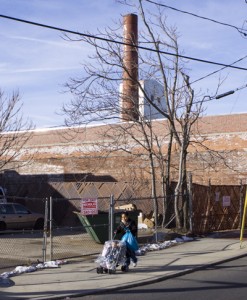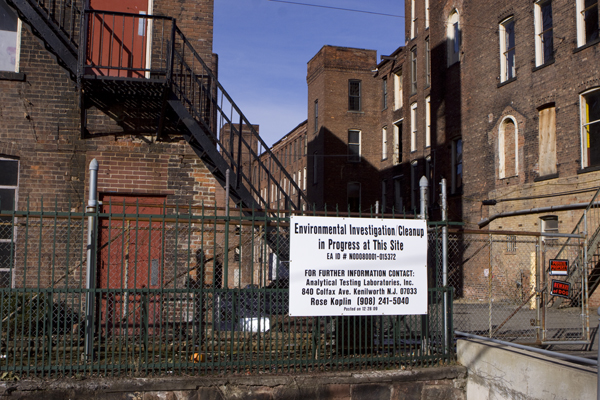[Update: 3/4/10 – DEP has revised the Paterson study and posted a new Final Report version dated 2/24 – while the concerns expressed here were valid at the time, disregard criticism of the deletions described below. More to follow on exactly how the changes to the Report happened – end update]
The Paterson air toxics study saga is nearly over. For recent context, please see:
DEP Suppressing Study That Shows Breathing Air in Paterson is Hazardous to Your Health
DEP Finds Unusual Toxic Chemical in Air in Chester
Below press release from PEER
NEW JERSEY DOWNPLAYS DISTURBING AIR TOXICS STUDY
DEP Mounts Messaging Campaign to Minimize Risk Findings in Paterson
 Trenton – A groundbreaking but long-delayed study of toxic air pollution in Paterson, New Jersey is finally being released this week with an elaborate state public relations roll-out designed to convince people that it contains nothing new, according to documents released today by Public Employees for Environmental Responsibility (PEER). Yet the draft of the study indicates that there are significantly increased health risks to residents from breathing ambient levels of numerous hazardous air pollutants.
Trenton – A groundbreaking but long-delayed study of toxic air pollution in Paterson, New Jersey is finally being released this week with an elaborate state public relations roll-out designed to convince people that it contains nothing new, according to documents released today by Public Employees for Environmental Responsibility (PEER). Yet the draft of the study indicates that there are significantly increased health risks to residents from breathing ambient levels of numerous hazardous air pollutants.
The $736,266.00 study, titled “Urban Community Air Toxics Monitoring Project, Paterson City, NJ” was initiated in October 2004 and is three years behind schedule. The study finds the “combined cancer risk” from exposure to toxic chemicals at the high end of what the U.S. EPA considers acceptable risk, and over 700 times higher than New Jersey’s cancer risk standard of one in a million. However, the DEP-prepared “Citizens Guide” for the study does not even mention combined cancer risks even though they are a central focus of the study and at the forefront of environmental justice concerns.
Rather than highlight the meaning and significance of monitoring data, a four-page “Communication Strategy” by the state Department of Environmental Protection (DEP) appears crafted to deflect questions with misleading conclusions not found in the study itself, such as:
- “There is no immediate public health concern” – a conclusion that ignores evidence of significant long-term and cumulative effects;
- “The air quality in Paterson is consistent with that of the entire state” – a vague statement that ignores many specific findings such as chlorine levels in Paterson more than 100 times higher than EPA national model estimates; and
- “The cancer risk [for p-dichlorobenzene, one of 132 toxics measured] calculated at the one site in Paterson where the elevated concentrations occurred would be 205 in a million” while neglecting to mention that this is more than 200 times the one in a million cancer risk guideline used by DEP and that even higher cancer risks were found at other monitoring sites
“DEP seems to be spending more time and money on political science than environmental science,” stated New Jersey PEER Director Bill Wolfe, a former DEP analyst, noting that the agency is withholding more than 100 documents concerning why the final report was delayed and how it was edited. “The study’s peer-reviewed data and conclusions were being presented months ago at technical conferences but not shared with the Paterson community until now.”
The DEP Communication Strategy spells out “messages” to assuage “concerned stakeholder groups” (public officials, environmentalists and community organizations). The memo also declares that Paterson was chosen for the study “NOT because of observed or suspected air quality problems.” In fact, the study author states that Paterson was selected because it has a hospitalization rate for asthma three times the state average and more than one in five 3rd graders have asthma or a related health problem. Previous studies associate toxic air pollution with asthma. In addition, Paterson is a racially mixed, relatively poor city meeting the DEP criteria for an “environmental justice community” that suffers from disproportionate pollution.
“The reason for this study was to find out where the pollution is coming from and to reduce it through tougher permitting or enforcement actions to promote environmental justice and public health. But instead of vigorous enforcement, DEP is treating like it is some unimportant academic exercise,” Wolfe added. “Did taxpayers get their money’s worth for this study or will it just take up space on a shelf?”
###
Read DEP Communications Strategy memo
Look at the summary draft Paterson toxics study (text available upon request)
See the draft DEP Citizens Guide (with staff edits)
Review the DEP penchant for suppressing and altering scientific studies
New Jersey PEER is a state chapter of a national alliance of state and federal agency resource professionals working to ensure environmental ethics and government accountability.


Pingback: WolfeNotes.com » DEP Cancels Public Meeting on Air Pollution Study – Private Briefing with Mayor Today
Pingback: WolfeNotes.com » DEP Guts Science on Cumulative Cancer Risks in Paterson NJ
Pingback: WolfeNotes.com » DEP Protecting Polluters, Not People
Pingback: WolfeNotes.com » Father of Environmental Justice Movement Speaks at Drew
Pingback: WolfeNotes.com » Something Is Rotten in the City of Paterson, NJ
Pingback: WolfeNotes.com » Clean Air Council Looks Forward – Ignores Elephant in the Room
Pingback: WolfeNotes.com » Air Heads
Pingback: WolfeNotes.com » Baseline Conditions For Upcoming DEP Environmental Justice Regulations – The View From Harding Township, NJ